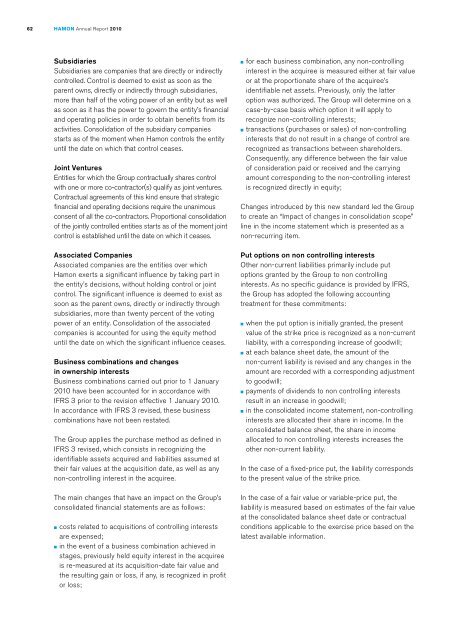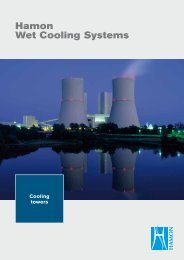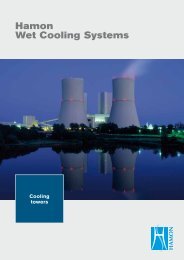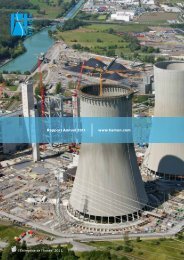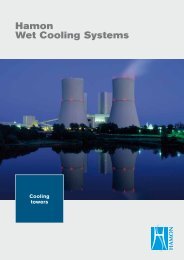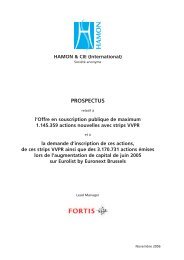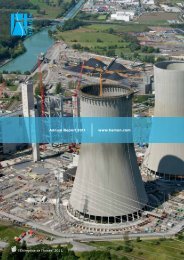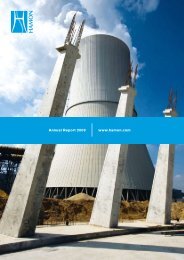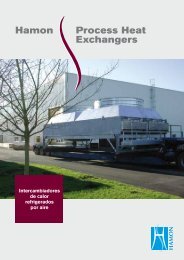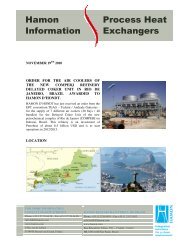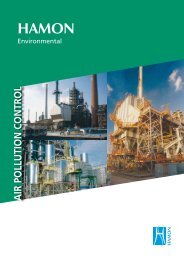Download PDF version English(2664KB) - Hamon
Download PDF version English(2664KB) - Hamon
Download PDF version English(2664KB) - Hamon
You also want an ePaper? Increase the reach of your titles
YUMPU automatically turns print PDFs into web optimized ePapers that Google loves.
62<br />
<strong>Hamon</strong> Annual Report 2010<br />
Subsidiaries<br />
Subsidiaries are companies that are directly or indirectly<br />
controlled. Control is deemed to exist as soon as the<br />
parent owns, directly or indirectly through subsidiaries,<br />
more than half of the voting power of an entity but as well<br />
as soon as it has the power to govern the entity’s financial<br />
and operating policies in order to obtain benefits from its<br />
activities. Consolidation of the subsidiary companies<br />
starts as of the moment when <strong>Hamon</strong> controls the entity<br />
until the date on which that control ceases.<br />
Joint Ventures<br />
Entities for which the Group contractually shares control<br />
with one or more co-contractor(s) qualify as joint ventures.<br />
Contractual agreements of this kind ensure that strategic<br />
financial and operating decisions require the unanimous<br />
consent of all the co-contractors. Proportional consolidation<br />
of the jointly controlled entities starts as of the moment joint<br />
control is established until the date on which it ceases.<br />
Associated Companies<br />
Associated companies are the entities over which<br />
<strong>Hamon</strong> exerts a significant influence by taking part in<br />
the entity’s decisions, without holding control or joint<br />
control. The significant influence is deemed to exist as<br />
soon as the parent owns, directly or indirectly through<br />
subsidiaries, more than twenty percent of the voting<br />
power of an entity. Consolidation of the associated<br />
companies is accounted for using the equity method<br />
until the date on which the significant influence ceases.<br />
Business combinations and changes<br />
in ownership interests<br />
Business combinations carried out prior to 1 January<br />
2010 have been accounted for in accordance with<br />
IFRS 3 prior to the revision effective 1 January 2010.<br />
In accordance with IFRS 3 revised, these business<br />
combinations have not been restated.<br />
The Group applies the purchase method as defined in<br />
IFRS 3 revised, which consists in recognizing the<br />
identifiable assets acquired and liabilities assumed at<br />
their fair values at the acquisition date, as well as any<br />
non-controlling interest in the acquiree.<br />
The main changes that have an impact on the Group’s<br />
consolidated financial statements are as follows:<br />
■ costs related to acquisitions of controlling interests<br />
are expensed;<br />
■ in the event of a business combination achieved in<br />
stages, previously held equity interest in the acquiree<br />
is re-measured at its acquisition-date fair value and<br />
the resulting gain or loss, if any, is recognized in profit<br />
or loss;<br />
■ for each business combination, any non-controlling<br />
interest in the acquiree is measured either at fair value<br />
or at the proportionate share of the acquiree’s<br />
identifiable net assets. Previously, only the latter<br />
option was authorized. The Group will determine on a<br />
case-by-case basis which option it will apply to<br />
recognize non-controlling interests;<br />
■ transactions (purchases or sales) of non-controlling<br />
interests that do not result in a change of control are<br />
recognized as transactions between shareholders.<br />
Consequently, any difference between the fair value<br />
of consideration paid or received and the carrying<br />
amount corresponding to the non-controlling interest<br />
is recognized directly in equity;<br />
Changes introduced by this new standard led the Group<br />
to create an “Impact of changes in consolidation scope”<br />
line in the income statement which is presented as a<br />
non-recurring item.<br />
Put options on non controlling interests<br />
Other non-current liabilities primarily include put<br />
options granted by the Group to non controlling<br />
interests. As no specific guidance is provided by IFRS,<br />
the Group has adopted the following accounting<br />
treatment for these commitments:<br />
■ when the put option is initially granted, the present<br />
value of the strike price is recognized as a non-current<br />
liability, with a corresponding increase of goodwill;<br />
■ at each balance sheet date, the amount of the<br />
non-current liability is revised and any changes in the<br />
amount are recorded with a corresponding adjustment<br />
to goodwill;<br />
■ payments of dividends to non controlling interests<br />
result in an increase in goodwill;<br />
■ in the consolidated income statement, non-controlling<br />
interests are allocated their share in income. In the<br />
consolidated balance sheet, the share in income<br />
allocated to non controlling interests increases the<br />
other non-current liability.<br />
In the case of a fixed-price put, the liability corresponds<br />
to the present value of the strike price.<br />
In the case of a fair value or variable-price put, the<br />
liability is measured based on estimates of the fair value<br />
at the consolidated balance sheet date or contractual<br />
conditions applicable to the exercise price based on the<br />
latest available information.


